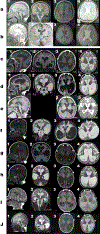El-Hattab-Alkuraya syndrome caused by biallelic WDR45B pathogenic variants: Further delineation of the phenotype and genotype
- PMID: 35322404
- PMCID: PMC9359317
- DOI: 10.1111/cge.14132
El-Hattab-Alkuraya syndrome caused by biallelic WDR45B pathogenic variants: Further delineation of the phenotype and genotype
Abstract
Homozygous pathogenic variants in WDR45B were first identified in six subjects from three unrelated families with global development delay, refractory seizures, spastic quadriplegia, and brain malformations. Since the initial report in 2018, no further cases have been described. In this report, we present 12 additional individuals from seven unrelated families and their clinical, radiological, and molecular findings. Six different variants in WDR45B were identified, five of which are novel. Microcephaly and global developmental delay were observed in all subjects, and seizures and spastic quadriplegia in most. Common findings on brain imaging include cerebral atrophy, ex vacuo ventricular dilatation, brainstem volume loss, and symmetric under-opercularization. El-Hattab-Alkuraya syndrome is associated with a consistent phenotype characterized by early onset cerebral atrophy resulting in microcephaly, developmental delay, spastic quadriplegia, and seizures. The phenotype appears to be more severe among individuals with loss-of-function variants whereas those with missense variants were less severely affected suggesting a potential genotype-phenotype correlation in this disorder. A brain imaging pattern emerges which is consistent among individuals with loss-of-function variants and could potentially alert the neuroradiologists or clinician to consider WDR45B-related El-Hattab-Alkuraya syndrome.
Keywords: WDR45B; autophagy; autosomal recessive (AR) trait; brain atrophy; neurodevelopmental disorders (NDD).
© 2022 John Wiley & Sons A/S . Published by John Wiley & Sons Ltd.
Conflict of interest statement
COMPETING INTERESTS
J.R.L. has stock ownership in 23andMe, is a paid consultant for Regeneron Genetics Center, and is a co-inventor on multiple United States and European patents related to molecular diagnostics for inherited neuropathies, eye diseases, genomic disorders, and bacterial genomic fingerprinting. The Department of Molecular and Human Genetics at Baylor College of Medicine receives revenue from clinical genetic testing conducted at Baylor Genetics (BG); J.R.L. serves on the Scientific Advisory Board (SAB) of BG. WKC is a paid consultant for Regeneron Genetics Center.
Other authors declare no conflict of interest
Figures



Similar articles
-
WIPI proteins: Biological functions and related syndromes.Front Mol Neurosci. 2022 Sep 9;15:1011918. doi: 10.3389/fnmol.2022.1011918. eCollection 2022. Front Mol Neurosci. 2022. PMID: 36157071 Free PMC article. Review.
-
WDR45B-related intellectual disability, spastic quadriplegia, epilepsy, and cerebral hypoplasia: A consistent neurodevelopmental syndrome.Clin Genet. 2018 Feb;93(2):360-364. doi: 10.1111/cge.13054. Epub 2017 Sep 7. Clin Genet. 2018. PMID: 28503735
-
Homozygosity for a nonsense variant in AIMP2 is associated with a progressive neurodevelopmental disorder with microcephaly, seizures, and spastic quadriparesis.J Hum Genet. 2018 Jan;63(1):19-25. doi: 10.1038/s10038-017-0363-1. Epub 2017 Nov 16. J Hum Genet. 2018. PMID: 29215095
-
Biallelic GRM7 variants cause epilepsy, microcephaly, and cerebral atrophy.Ann Clin Transl Neurol. 2020 May;7(5):610-627. doi: 10.1002/acn3.51003. Epub 2020 Apr 14. Ann Clin Transl Neurol. 2020. PMID: 32286009 Free PMC article.
-
Homozygous variants in pyrroline-5-carboxylate reductase 2 (PYCR2) in patients with progressive microcephaly and hypomyelinating leukodystrophy.Am J Med Genet A. 2017 Feb;173(2):460-470. doi: 10.1002/ajmg.a.38049. Epub 2016 Nov 11. Am J Med Genet A. 2017. PMID: 27860360 Review.
Cited by
-
Autophagy genes in biology and disease.Nat Rev Genet. 2023 Jun;24(6):382-400. doi: 10.1038/s41576-022-00562-w. Epub 2023 Jan 12. Nat Rev Genet. 2023. PMID: 36635405 Free PMC article. Review.
-
WIPI proteins: Biological functions and related syndromes.Front Mol Neurosci. 2022 Sep 9;15:1011918. doi: 10.3389/fnmol.2022.1011918. eCollection 2022. Front Mol Neurosci. 2022. PMID: 36157071 Free PMC article. Review.
-
Comprehensive analysis of autophagic functions of WIPI family proteins and their implications for the pathogenesis of β-propeller associated neurodegeneration.Hum Mol Genet. 2023 Aug 7;32(16):2623-2637. doi: 10.1093/hmg/ddad096. Hum Mol Genet. 2023. PMID: 37364041 Free PMC article.
-
A homozygous variant of WDR45B results in global developmental delay: Additional case and literature review.Mol Genet Genomic Med. 2022 Oct;10(10):e2036. doi: 10.1002/mgg3.2036. Epub 2022 Aug 13. Mol Genet Genomic Med. 2022. PMID: 35962600 Free PMC article. Review.
-
Dysregulated proteostasis network in neuronal diseases.Front Cell Dev Biol. 2023 Feb 24;11:1075215. doi: 10.3389/fcell.2023.1075215. eCollection 2023. Front Cell Dev Biol. 2023. PMID: 36910151 Free PMC article. Review.
References
Publication types
MeSH terms
Supplementary concepts
Grants and funding
LinkOut - more resources
Full Text Sources
Medical
Research Materials

